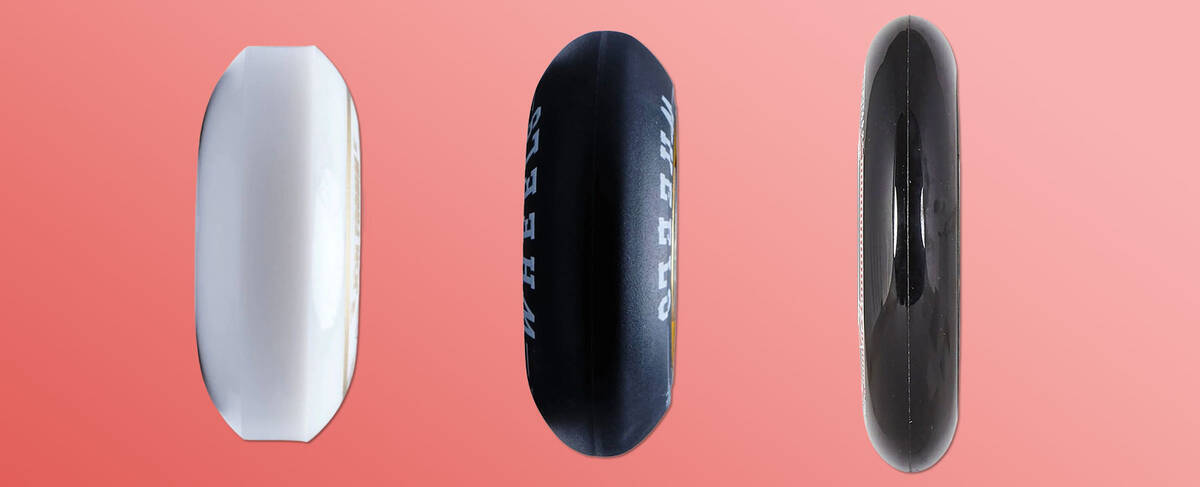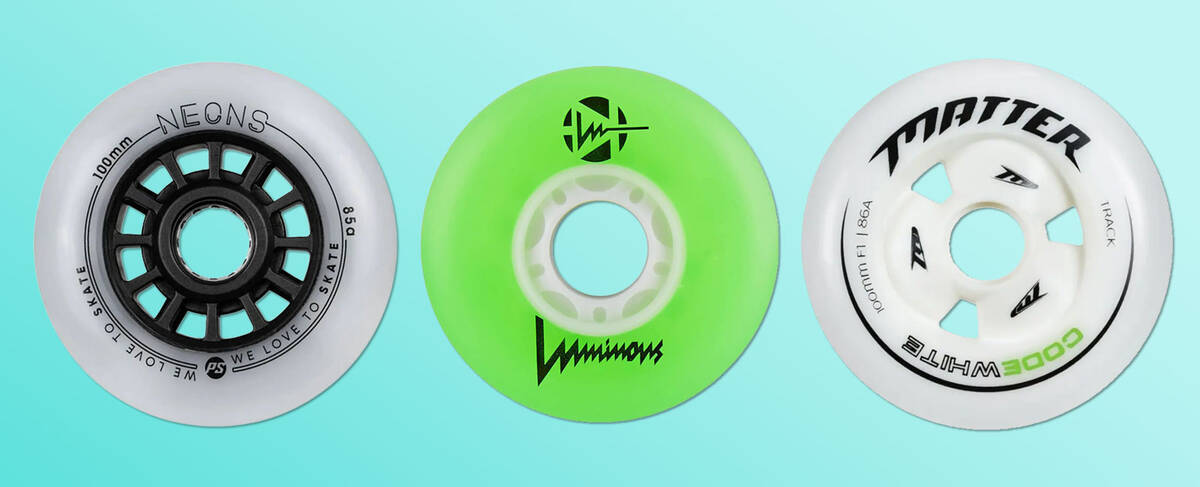Inline Skate Wheels - An All-Inclusive Guide

- Wheel size: Influences both speed and manoeuvrability.
- Durometer: Indicates wheel hardness – it affects speed and vibration absorption.
- Rebound: Explains how rapidly the wheel returns to its original form after compression.
- Grip: Describes the wheel's ability to stay on the surface.
- Wheel profile: Impacts speed alongside stability.
Overview
Overview
Which Inline Skate Wheels Should You Choose?

Selecting inline skate wheels becomes simpler with knowledge of which kind is best recommended for your skating style.
No matter your preferred style of inline skating, it’s crucial to consider both the size and hardness of the wheels, ensuring they match the surfaces you’ll be skating on.
| Style of Inline Skating | Characteristics | Size Range / Hardness Range |
| Fitness Skate Wheels |
Smooth roll Power transfer
|
80-110 mm 80A-88A |
| Freeskate Wheels |
Rapid and agile |
75-110 mm 84A-88A |
| Aggressive Skate Wheels |
Stable with shock absorption Compact size Flat or rounded profiles |
55-80 mm 88A-95A |
| Roller Hockey Wheels |
Grippy with agility Great acceleration Some made for indoor use |
65-84 mm 72-84A
|
| Speed Skate Wheels |
Top speed oriented Suitable for indoors/rinks/outdoors/roads |
100 mm-125 mm 83A-90A |
Inline Skate Wheels Compatibility

With a typical width of 24 mm, inline skate wheels are generally easy to find and fit on your rollerblades. Wheels smaller than or equivalent to the largest diameter permitted for your frames can be installed without issue.
Understanding factors such as hardness, rebound, grip, and profile will aid in selecting wheels that both fit and boost the performance of your skates.
Continue reading for further insights or head directly to our collection:
Inline Skate Wheel Size - Diameter

The size of inline skate wheels is represented in millimetres (mm) and is generally etched on the wheel's side. If uncertain, you can always measure the diameter on your own.
The diameter detail profoundly affects how inline skate wheels behave. Aspects like maneuverability, directional stability, acceleration, and speed are all closely tied to wheel size.
Wheel diameter affects inline skates' performance thusly:
- Smaller diameter: Allows for better acceleration and control.
- Larger diameter: Promotes higher top speeds and enhances directional stability.
Suitable wheel size varies according to your skating style. Our guidance chart below provides general advice for various skating styles:
Size Chart for Inline Skate Wheels
| Inline Skating Style | Size Range |
| Aggressive Skate Wheels | 55-80 mm |
| Roller Hockey Wheels | 65-84 mm |
| Fitness Skate Wheels | 80-110 mm |
| Freeskate Wheels | 75-110 mm |
| Speed Skate Wheels | 100-125 mm |
Hardness - Inline Skate Wheel Durometer

Durometer is the typical label for an inline skate wheel's relative hardness, with the A-scale being most commonly adopted. The number you see, often followed by an A (such as 82A), indicates hardness, where a higher value reflects a harder wheel.
Finding a wheel's durometer rating on the side makes it effortless to gauge relative tough ness.
The optimal wheel hardness is contingent upon your skating style. Our chart below offers guidelines to help you choose the correct hardness for your inline skating preferences:
Hardness Chart for Inline Skate Wheels
| Inline Skating Style | Hardness Range |
| Aggressive Skate Wheels | 88A-95A |
| Roller Hockey Wheels | 72A-84A |
| Fitness Skate Wheels | 80A-88A |
| Freeskate Wheels | 84A-88A |
| Speed Skate Wheels | 83A-90A |
Wheel hardness plays an essential role in how they react to various surfaces and conditions - carefully consider this for optimal performance.
Comparison: Hard vs. Soft Inline Skate Wheels
Understanding the performance impact from choosing between wheels of differing hardness levels is critical.
The effect of hardness on rollerblade wheel performance:
Harder wheel advantages- Higher speeds
- Enhanced durability
- Reduced grip
- Vibration absorption decreases
- Improved grip
- Enhanced shock absorption
- Reduced speed
- Less durability
The general advice is that softer wheels excel in scenarios requiring vibration damping and additional grip; harder options, conversely, are less effective in these regards.
Alternative HARDNESS MEASURES
Some manufacturers employ the footprint scale instead. Here’s how it aligns with the A-scale:
- F0 - similar to 88A
- F1 - similar to 85A
- F2 - similar to 84A
- F3 - similar to 83A
Understanding Inline Skate Wheel Rebound
Rebound indicates how swiftly a wheel returns to its original shape once compressed. A wheel with elevated rebound will quickly spring back, contributing to speed. In contrast, a wheel with lower rebound absorbs the energy and diminishes speed.
Wheels of superior quality often possess high rebound properties, commonly labelled as SHR urethane - Super High Rebound. While no uniform standard for comparing rebound exists, pricier, well-renowned wheels usually boast higher levels.
Inline Skate Wheel Grip Explanation
The wheels' grip largely relies on the PU (polyurethane) composition, specifically the rubber blend used. Hardness also plays a key role.
The correlation between wheel hardness and grip is as follows:
- Softer wheels: Provide more grip.
- Harder wheels: Offer less grip.
The surface affects the degree of grip required. Slicker environments, like indoor rinks, necessitate more grip to prevent slipping, while grip is less strained on coarser surfaces like tarmac.
When skating on rough areas, opting for harder wheels can be acceptable without drastic traction loss.
Wheel Profile for Inline Skates

Wheel profiles, from flat to pointy, affect the contact surface with the ground. A flatter profile increases the contact area, while a pointy one reduces it.
Pointy profiles are standard across many skating disciplines, from fitness to racing, due to lower friction and enhanced efficiency. They are largely favoured for their versatility.
Flat profiles are reserved for aggressive skating, providing stability needed for trick landings, despite slower speeds.
Round profiles show up in both frees kating and aggressive skating, ideally in flat setups to minimize wheel bites and ease control, ideal for novices.
Understanding the Hub of Inline Skate Wheels

The central part of a wheel, known as the hub, ensures bearings alignment. Constructed usually from sturdy plastic or aluminum, aluminum cores tend to be heavier but more durable against impact than plastic.
Main hub categories include:
- Solid core: Durable but heavier.
- Spoked core: Lightweight, less durable.
- Hollow core: Balances weight with durability.
Optimizing inline skate performance requires balancing strength and durability with lightness, which allows using less energy and reducing tiredness.
Maintenance of Inline Skate Wheels
To maximize the life of your wheels, proper care is a must. As the most rapidly wearing parts, strategic maintenance can achieve cost savings. Establishing and following a wheel-rotation routine can extend their usability, maintaining skate performance.
Wheels naturally tend to wear such that their centre becomes misaligned, forming a diagonal flat surface on the inside. This pattern isn’t ideal for technique, signalling the time to rotate your wheels.
Regularly rotating your rollerblade wheels helps maintain their shape. If you're unsure how to go about this, we suggest consulting our detailed guide:
If you're uncertain about whether it's time for replacement inline skate wheels, our guide provides clarity on the matter:
Need assistance with wheel installation? This guide will help:
For general upkeep of your inline skates, check out our comprehensive online maintenance guide:
... What About Bearings?
Our wheel bearings guide thoroughly explains their functionality:
If you're experiencing a less smooth roll, worn bearings might be the culprit. Consider thorough cleaning and lubrication in that scenario:


